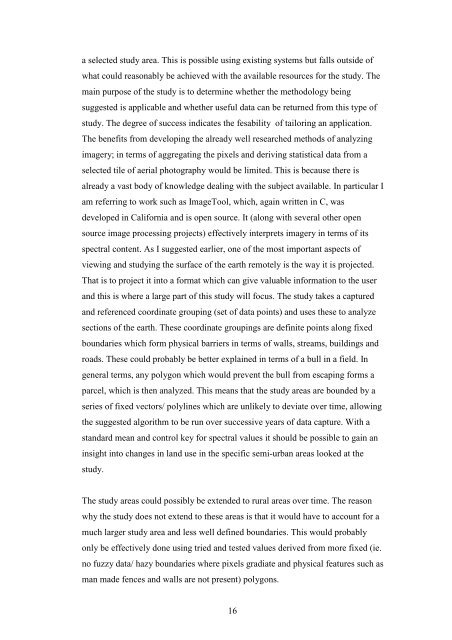You also want an ePaper? Increase the reach of your titles
YUMPU automatically turns print PDFs into web optimized ePapers that Google loves.
a selected study area. This is possible using existing systems but falls outside of<br />
what could reasonably be achieved with the available resources for the study. The<br />
main purpose of the study is to determine whether the methodology being<br />
suggested is applicable and whether useful data can be returned from this type of<br />
study. The degree of success indicates the fesability of tailoring an application.<br />
The benefits from developing the already well researched methods of analyzing<br />
imagery; in terms of aggregating the pixels and deriving statistical data from a<br />
selected tile of aerial photography would be limited. This is because there is<br />
already a vast body of knowledge dealing with the subject available. In particular I<br />
am referring to work such as ImageTool, which, again written in C, was<br />
developed in California and is open source. It (along with several other open<br />
source image processing projects) effectively interprets imagery in terms of its<br />
spectral content. As I suggested earlier, one of the most important aspects of<br />
viewing and studying the surface of the earth remotely is the way it is projected.<br />
That is to project it into a format which can give valuable information to the user<br />
and this is where a large part of this study will focus. The study takes a captured<br />
and referenced coordinate grouping (set of data points) and uses these to analyze<br />
sections of the earth. These coordinate groupings are definite points along fixed<br />
boundaries which form physical barriers in terms of walls, streams, buildings and<br />
roads. These could probably be better explained in terms of a bull in a field. In<br />
general terms, any polygon which would prevent the bull from escaping forms a<br />
parcel, which is then analyzed. This means that the study areas are bounded by a<br />
series of fixed vectors/ polylines which are unlikely to deviate over time, allowing<br />
the suggested algorithm to be run over successive years of data capture. With a<br />
standard mean and control key for spectral values it should be possible to gain an<br />
insight into changes in land use in the specific semi-urban areas looked at the<br />
study.<br />
The study areas could possibly be extended to rural areas over time. The reason<br />
why the study does not extend to these areas is that it would have to account for a<br />
much larger study area and less well defined boundaries. This would probably<br />
only be effectively done using tried and tested values derived from more fixed (ie.<br />
no fuzzy data/ hazy boundaries where pixels gradiate and physical features such as<br />
man made fences and walls are not present) polygons.<br />
16
















